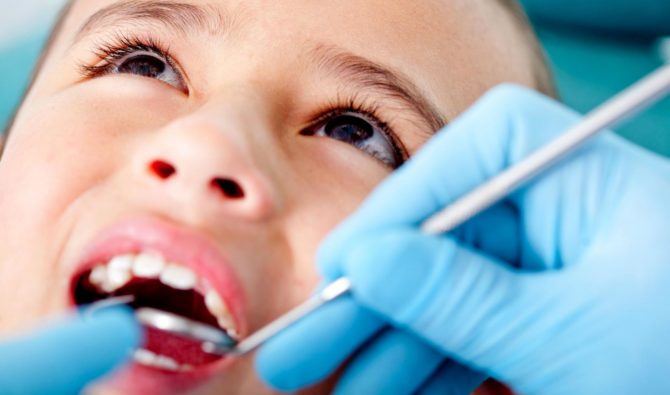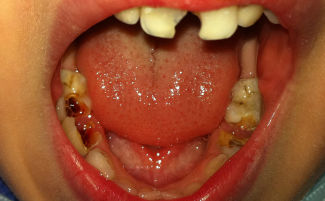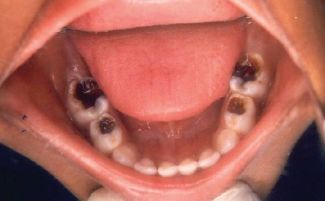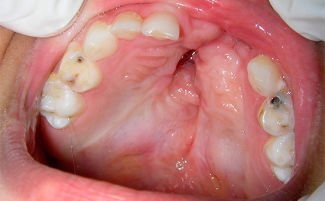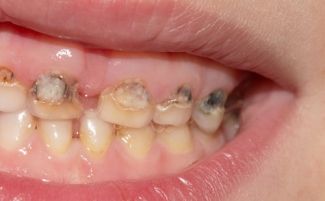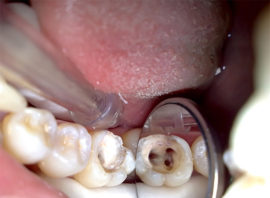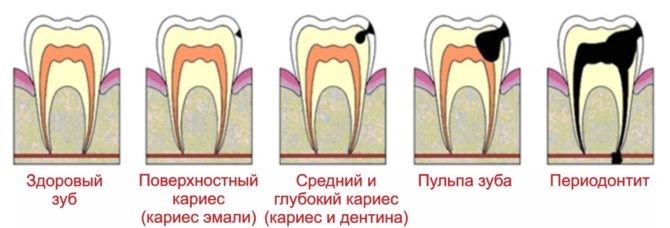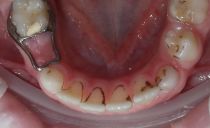Pulpitis of a baby tooth in a child - symptoms, stages of treatment, prevention
Acute or chronic pulpitis of a baby tooth in children occurs on the background untreated caries in time. Inflammation of the pulp can cause acute pain, but sometimes it passes and is asymptomatic. The disease, unexpressed by pain, is due to the special structure of children's teeth.
With a similar course of pulpitis of milk teeth, parents often go to the doctor too late. The infection process is already beyond the scope of diseased tissue, causing complications and a host of other dental problems. Therefore, it is important to pay attention to any complaints of the child.
Content
- Features of pulpitis in children
- Pulpitis Symptoms
- Photo of pulpitis of milk teeth in children
- Chronic pulpitis
- How to treat pulpitis of deciduous teeth in children
- Complications after pulpitis treatment
- Anxiety symptoms after treatment
- Treatment of acute pulpitis of milk teeth folk remedies
- Pulpitis Prevention
Features of pulpitis in children
Unlike an adult, pulpitis in baby teeth in a child develops much faster and more often passes into deeper tissues, requiring immediate treatment:
- thin enamel of a milk tooth with a small content of dentin weakly protects its inside from the effects of bacteria;
- the child has wider dentinal canals than adults, as a result of which the disease progresses faster, unformed roots;
- enlarged pulp, to which pathogens are easier to get than to the molar.
Detection of the disease and timely treatment of pulpitis in children is complicated by a good outflow of fluid from the inflamed area, due to which the pain signaling the body about the problem is slightly expressed or completely absent.
Pulpitis Symptoms
Pulpitis of milk teeth is acute and chronic. According to statistics, pulpitis in a child 4-7 years old in acute form is less common than in chronic. The acute form of this disease has 2 stages: purulent and serous. Each form has its own symptomatology. The transition time from one stage to another takes no more than a day, usually several hours.
With a serous form, pain is usually not intense. At this phase, they are the least likely to see a doctor. In the purulent stage, the pain becomes stronger, but also not always. With good immunity, a large carious cavity through which pus exits, pain may be absent. Milk teeth pulpitis can be suspected if:
- the baby experiences intense pain when chewing;
- he had a fever;
- when examining the oral cavity, purulent exudate is observed;
- the child complains of pain.
Photo of pulpitis of milk teeth in children
Chronic pulpitis
Children's chronic pulpitis of primary teeth can be both with a deep carious cavity and under a seal. If there is a suspicion of pulpitis of primary teeth, it is necessary to make a fluoroscopic gene for making an accurate diagnosis. There are three forms of chronic pulpitis:
- fibrous;
- gangrenous;
- hypertrophic.
Pain with a chronic fibrous form of the disease occurs when pressed, from exposure to cold and hot, when food enters the area of inflammation. This type of pulpitis among children is most common. With this form, tooth extraction is not recommended.
A gangrenous type of disease is characterized by a change in the color of the tooth in a gray or dark color, different from the shade of healthy teeth.Pain in this form occurs from hot and does not appear immediately after exposure to the stimulus, but after a while. Gangrenous chronic pulpitis may be accompanied by a feeling of fullness in the tooth, an unpleasant odor from the oral cavity. More often this type of inflammatory process with untimely treatment ends with periodontitis.
Hypertrophic pulpitis in children is the rarest form of the disease. It is characterized by the growth of pulp in the carious cavity. She goes literally outside and is constantly in contact with external stimuli.
How to treat pulpitis of deciduous teeth in children
Effective treatment of pulpitis of deciduous teeth in children begins by eliminating the source of inflammation. Modern dentistry offers several ways to treat childhood pulpitis:
- amputation;
- biological;
- devital.
Amputation treatment of pulpitis
This is one of the most radical ways to treat pulpitis on baby teeth. Amputation treatment of pulpitis of deciduous teeth involves the complete or partial removal of inflamed pulp. The procedure is mandatory with complete anesthesia. Some parents even insist on general anesthesia. This service is provided by a clinic in Moscow and other large cities.
With the complete removal of the pulp, you can be sure that the relapse of the disease is no longer threatened by this tooth. But here there are some nuances. The pulp covers the periapical tissues, and after its amputation they become more accessible for pathogens. This approach requires careful work and good professionalism from the doctor, because the diseased area must be removed so as not to touch the adjacent periodontal tissues.
Complete amputation treatment of primary teeth in children from pulpitis is a complex, painful procedure divided into several stages.
Removing part of the pulp involves only cutting off its coronal part. The doctor preserves the lower root section to protect healthy tissues located under the pulp. During the execution of such a procedure, three rules must be observed:
- use several sterile nozzles to prevent infection of the lower tissues;
- thoroughly treat a sick tooth with an antiseptic;
- carefully select drugs and doses to stop the bleeding of the pulp when cutting off its upper part.
Biological treatment of pulpitis
The biological method allows you to cure pulpitis in children of primary teeth by a conservative method. This is a fairly common and traditional method of treatment among many pediatric dentists. The undoubted advantage of biological treatment is the absence of serious surgical intervention.
The dentist opens the diseased pulp and fills it with medical material from a mixture of artificial dentin and Shostakovsky balm. Dentists sometimes use Calcemin. After the mixture has dried, the tooth is filled and the patient is allowed to go home, prescribing Pulpotek.
The disadvantages of conservative treatment:
- the existing probability of the transition of inflammation to periodontium;
- the healing process is long;
- the possibility of complications.
Devital Pulpitis Treatment
The devital method allows treating tooth pulpitis in a child by completely removing infected tissue. It differs from the amputation method in a milder, gentle effect and passes in several stages:
 The tooth is anesthetized.
The tooth is anesthetized.- A substance is used to inflame the diseased tissue - an arsenic paste - on an inflamed pulp. If the stage of the disease has acquired a gangrenous form, phenol or formalin is used.
- Depending on the drug used, the product is left in the cavity for a period of 2 to 14 days. Only the doctor has the right to give a clear instruction on the duration of the period and on the care of the teeth during this time to the patient. Sometimes Pulpotec is prescribed to prevent complications.
- At the next visit to the dentist, the doctor cleans the cavity of the diseased tooth from dead tissue.
- Further, a swab with a resorcinol-formalin mixture is applied to the prepared area, which saturates the healthy part of the tooth with microelements that contribute to the growth of permanent teeth.
- On the third and final visit, the cured tooth is filled.
The disadvantages of this method include a long treatment time. The benefits include painlessness, a mild effect, the use of painkillers and only safe therapeutic agents.
The undoubted advantages of devital treatment include the absence of a child’s stress state, in comparison with other methods, and universality - the possibility of use in any form of the disease.
Complications after pulpitis treatment
Only a competent, experienced pediatrician should treat pulpitis of milk teeth in children. Choosing such a specialist is the direct task of the parents. Illiterate actions of a negligent dentist can lead to complications and re-treatment of pulpitis.
Most often, complications occur due to:
- Incorrect application of arsenic paste. A loose patch can provoke leakage of arsenic, getting it on the mucous membrane of the inner surface of the cheek, gums, tongue. This is unacceptable, because when interacting with healthy organs, arsenic will cause their necrosis.
- Arsenic swab too tight. You can get a mucous burn.
- Incorrectly calculated arsenic volume. If the funds were too much, intoxication of the child's body may occur.
- Wrong diagnosis.
- Incomplete pulp removal.
- Inaccurate action by the dentist. Negligence during treatment can lead to the development of inflammation in the soft tissues under the tooth or in a healthy part of it. For example, this situation can happen if the doctor accidentally hooks a periodontium with a needle.
Untreated baby pulpitis on a baby tooth can lead to serious complications such as periodontitis or periostitis.
Anxiety symptoms after treatment
In the first few days after treatment, parents should be alert for the following signs of complications:
- The child complains of pain in the cured tooth. It is important to wait a while. If the pain gradually subsides during the first day, then there is nothing special about it. This is a reaction of the body to interference and irritation of the mucosa. Should alert the pain that appeared in a few dayswhen the tooth no longer hurt or pain, the intensity of which does not decrease, but increases;
- Fever. A slight increase in temperature on the first day is quite possible due to stress experienced by the child. Parents should carefully monitor his condition, and if it happens that the temperature reaches 38 degrees, urgently show the child to the doctor.
Treatment of acute pulpitis of milk teeth folk remedies
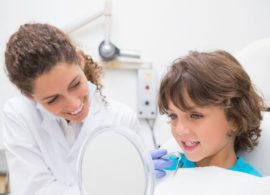 Sometimes, when pulpitis occurs in a child of 5 years or younger, parents are afraid to take him to a doctor and give him Pulpotec on his own or try to be treated with folk remedies. For these purposes, use hydrogen peroxide, propolis, calamus, lemon and other various medicinal herbs.
Sometimes, when pulpitis occurs in a child of 5 years or younger, parents are afraid to take him to a doctor and give him Pulpotec on his own or try to be treated with folk remedies. For these purposes, use hydrogen peroxide, propolis, calamus, lemon and other various medicinal herbs.
It is important to understand here that if such techniques help relieve pain, they are absolutely not effective in terms of treatment. It is impossible to cure pulpitis with folk remedies. In this case, the best thing that can be done for a child is to take him to a professional children's doctor. A good doctor will not only easily attract a small patient, but will also be able to entertain him during the treatment. For children, they even make special multi-colored fillings, which are incredibly popular among kids of all ages.
Pulpitis Prevention
For the prevention of any dental diseases, including pulpitis, there are a number of standard recommendations:
- It is necessary to rinse your mouth after each meal, especially after sweets and starchy foods.
- A visit to pediatric dentistry every six months will reveal caries and other problems in the early stages, eliminate the problem on time, without allowing complications.
- The child must learn to brush his teeth strictly 2 times a day with a good toothpaste and the right brush.
- It is important for any even minor complaints of the child for pain or discomfort in the oral cavity to show the baby to a specialist.
- Do not scare children with doctors, try to develop a positive dentist perception in the child. If the baby is not afraid of the doctor, he will not only allow himself to be examined calmly, but will also tell his parents in time about the first painful symptoms.
- Once a month, independently carry out a routine examination of the child's oral cavity for caries or pulpitis of milk teeth. If there is any suspicion, visit a doctor and take a fluoroscopy.
What is better, only a doctor can recommend treating or removing a milk tooth affected by pulpitis: first of all, you need to contact a dental clinic. It all depends on the stage of tooth decay, the form and type of the ongoing disease.
A milk tooth that has not been cured on time can not only cause complications, but also affect the rudiment of a permanent molar with caries.

